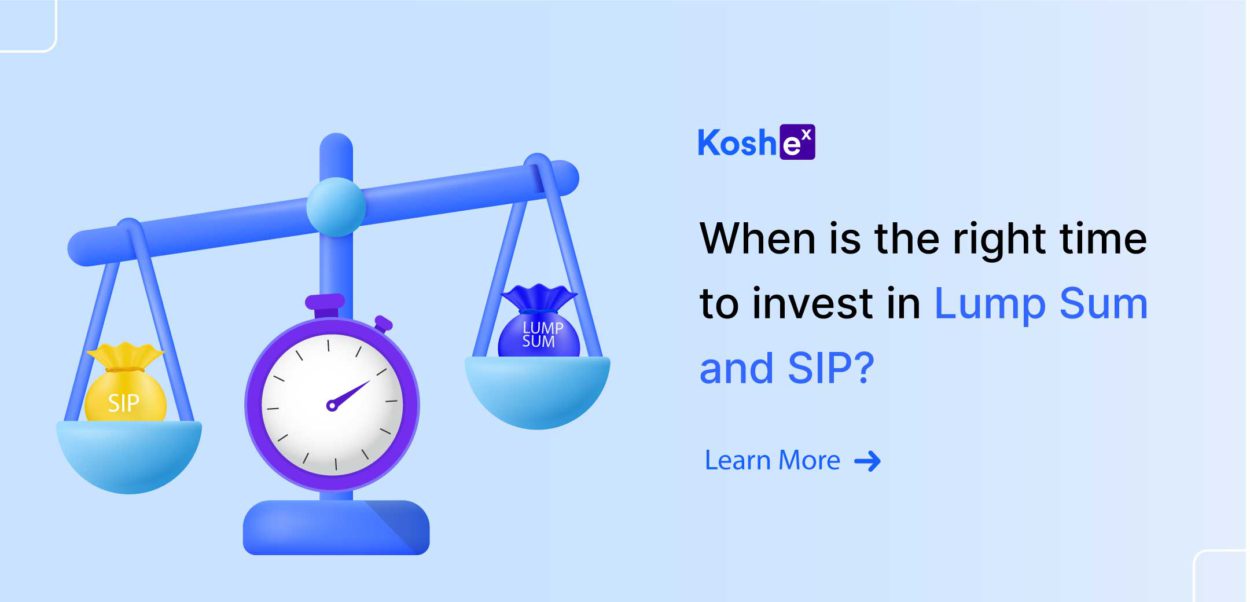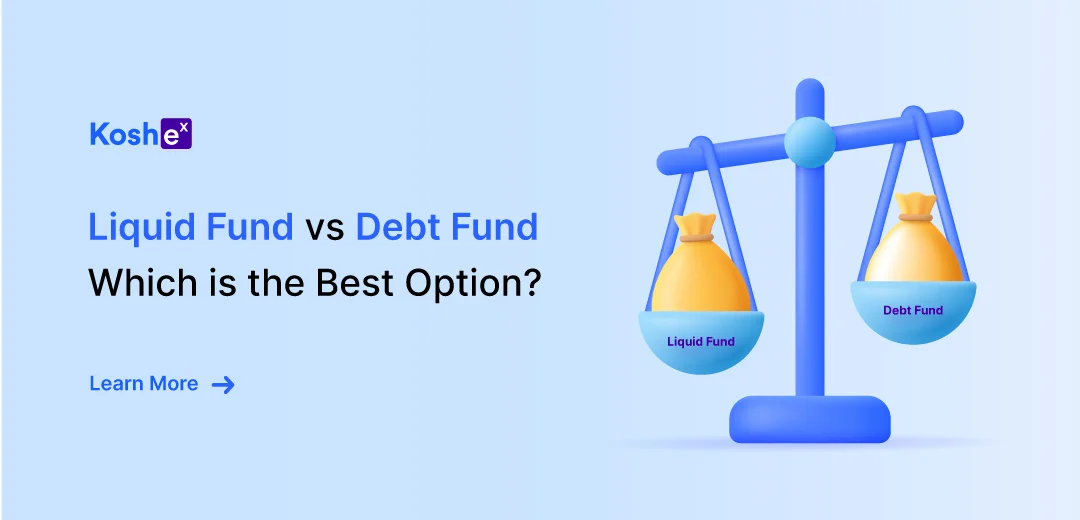Mutual fund schemes are one of the most preferred investment avenues for investors. Investors can invest in mutual funds through lump sum investment or a Systematic Investment Plan (SIP).
However, lump sum vs SIP has been one of the biggest dilemmas for any mutual fund investor. We often struggle to find the right time to invest in lump sum and SIP. What investors try is to select one of the two.
However, what if someone says that both can co-exist? Why select between them when you can choose both of them? Let’s get brief insights about lump sum and SIP investments and how Koshex can help us with our mutual fund investment journey.
What is a Lump Sum Investment?
A lump sum investment is a one-time investment into the mutual fund scheme. Here, the investor directly invests a significant amount into the scheme in one go.
Usually, mutual fund investors with high liquidity or disposable cash go for lump–sum investments. This can be due to selling an asset like a house, inheritance, or a lottery!
Following are the features and benefits of lump sum investment:
- Best way to park idle funds or sudden monetary gains
- Highly beneficial if the markets are at their lowest as we can get mutual fund units at their lowest rates
- Tax planning advantage if we fail to meet our investment targets (discussed in detail later on)
What is SIP Investment?
Also known as a Systematic Investment Plan, SIP is a continuous and regular investment in mutual fund schemes over time. It involves investing a fixed pre-determined amount each month on a specific date over some time.
The following are the features and benefits if we invest in SIP:
- Ideal for investors who can invest small amounts each month instead of a considerable amount together
- Helps in cultivating the habit of disciplined investing as we prioritize the SIP amount each month over other avenues
- SIP comes with two options – SIP Regular and SIP Insured. While SIP regular only consists of investments, SIP insured also provides insurance protection along with investment. The sum insured is usually 80-120 times the SIP amount. In case of the demise of the investor, the nominees will receive the investment value along with a sum equal to 80-120 times of monthly SIP amount as the sum insured.
Lump Sum vs SIP – What is the Right Time to Invest in Them?
Before investing, we should always consider our risk profile and investment horizon. Lump sum investments are an ideal choice when we have idle cash to invest. Further, a lump sum amount can be invested in debt funds that provide assured returns to the investors.
Also, they eliminate the need to time the market, as in the case of equity fund investments. This helps meet short-term needs. If the market is at its lowest or just beginning with the recovery, it’s an ideal time to make the lump sum investment.
Another significant benefit that lump sum investment confers on investors is that it acts as a tax planning tool, particularly at the close of the financial year.
We often miss out on our investment targets and the chances of tax liability increase. Section 80C of the Income Tax Act, 1961, allows a deduction of up to Rs. 1.50 lakhs for investments made in ELSS mutual funds. Investments can either be made in lump sum amounts or through SIP.
Therefore, we can meet our investment targets by making a lump sum investment near the end of the financial year.
However, if we don’t want to time the market, we can go for an SIP investment. SIP investment is an ideal choice for novice investors.
As a pre-determined amount is invested each month, the need to time the market is eliminated. Further, it also provides the benefit of rupee-cost averaging.
Rupee cost averaging is a benefit in the case of SIP investment that lump sum investment lacks. Here, investors get allotted more units when the prices are low.
And when the prices increase, the investors get a lower number of units but the overall portfolio value increases. Over the long run, the overall cost of investment averages out.
Systematic Transfer Plan (STP)
As stated earlier, we don’t need to select between the lump sum and SIP investment. Both can co-exist, and this is the ideal investment strategy. We should invest regularly using the SIP mode. This helps us inculcate the discipline towards investing.
Further, we can go for a lump sum investment whenever we have excess cash. However, how can you time the market here?
If the market is low or just beginning its recovery, we can make the lump sum investment. However, if we don’t want to time the market, we can use a Systematic Transfer Plan (STP).
Keeping our cash in the bank and waiting for the markets to rise can lead to reduced returns. So, we can invest in any debt mutual funds and start a Systematic Transfer Plan (STP).
In the case of STPs, a predetermined amount is transferred each month from one mutual fund to another instead of from the bank account. This ensures that we earn assured returns as our excessive cash stays invested in debt mutual funds while we also reap the benefits of SIP investments through STPs.
In a Nutshell
Both are effective ways to invest in mutual funds, whether a lump sum or a SIP investment. We can start with the SIP investment and continue for extended periods.
We could go for a lump sum investment or Systematic Transfer Plan (STP) whenever we have excess funds. STP makes it possible to reap lump sum and SIP investment benefits.
However, we must begin our mutual fund investment journey before deciding on a lumpsum or SIP investment.
Koshex is an online investment platform that allows us to invest in various mutual fund schemes. It also allows investors to invest in other avenues like digital gold, fixed, and smart deposits.
Further, it facilitates automating our investment journey, directly assisting in wealth creation. Thus, we must select the right fund that provides returns as per our investment goals and begin our investment journey. It’s time you start your mutual fund investment journey with Koshex.
Frequently Asked Questions
Can we make lump sum and SIP investments in a single mutual fund plan?
Yes. There is no restriction to making lump sum and SIP investments in a single mutual fund scheme.
Which is better – lumpsum or SIP?
Both lumpsum and SIP investment carry their benefits. However, one of the significant benefits of SIP is rupee cost averaging. This also serves as a drawback in the case of lumpsum investment as we need to time the market before making the lump sum investment. However, the need to time the market becomes irrelevant if we invest long.









Leave a Comment